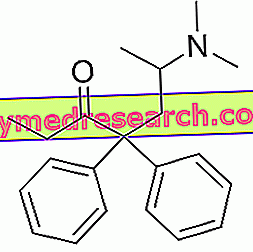Generality
The capoparto is the first menstruation that appears after childbirth .
This event frequently coincides with the end of the puerperium and, in women who do not breastfeed, usually occurs five or six weeks after the birth of the baby.
On the other hand, mothers who are breast-feeding, the reappearance of menstruation is delayed for constitutional reasons or due to hormonal alterations still in progress.

Generally, the ward is more abundant and prolonged than a common menstruation.
What is the capoparto?
For capoparto means the return of menstruation after completion of the birth; this event usually coincides with the end of the puerperium.
Often, the cycle starts again as soon as the baby is weaned: by reducing the number of feedings, the synthesis of prolactin decreases, which - in addition to being the hormone responsible for continuous milk production - inhibits ovulation.
The reappearance of the flow indicates the restoration of the menstrual cycle and the return of the uterus to its normal conditions ; the resumption of ovulatory activity may require, instead, a longer time, therefore the first cycles after the birth can be anovulatory .
puerperio
The puerperium is that period which follows the completion of the birth and which lasts about 45 days, or 6 to 8 weeks after the birth of the child. During this period, the uterus returns to its original size and the genital apparatus regains its pre-pregnancy shape.
The clinical manifestations of the puerperium generally reflect the regression of physiological changes that occurred during pregnancy . These changes are modest and temporary and should not be confused with pathological conditions.
At the end of the puerperium, especially if the woman is not breastfeeding, she will soon have the capoparto, that is the reappearance of menstruation .
When does it occur?
The capofarto can occur a few weeks after the baby is born or after several months. This depends significantly on whether or not you are breastfeeding.
- Normally, the return of menstruation tends to be delayed in women who breastfeed exclusively, due to the high level of the hormone prolactin which, in addition to being responsible for lactation, inhibits ovulation. The level of suppression of the ovulatory cycle can vary for each woman and depends, roughly, on the number of breastfeeds, but also on the appetite of the child. If the child's suction is infrequent, the greater the probability that ovulation occurs shortly after the birth and that the capoparto appears in advance; when breastfeeding occurs very often and longer, prolactin remains consistently high in the maternal organism and the cycle takes longer to restart.
Generally speaking, menstrual flow can recur from 70 days to several months after delivery, even up to the entire breastfeeding period.
- If the new mother does not breastfeed, on the other hand, menstruation can return in the 40-50 days following the birth of the baby.
A delay or advance in the wrap-up may also depend on constitutional reasons or hormonal alterations : after childbirth, the normal physiological balance tends to be reached at different speeds by women. Also the pathological processes affecting the genital apparatus can influence the return of the menstrual cycle.
How does it manifest itself?
The first menstruation after childbirth is usually abundant, as the endometrium, after many months of amenorrhea (absence of menstruation), is rather thickened. For this reason, the capoparto often involves intense clots and abdominal cramps. The duration of the menstrual flow is generally equal to 8-10 days, therefore greater than the norm.
Before the cycle returns to its usual characteristics, a few months must pass; this period is necessary for the resumption of a normal ovulatory activity (note: the capoparto clearly indicates that the reproductive system has returned to the pre-pregnancy form, but the ovaries need a longer time to synchronize again to the physiological rhythms).
Therefore, it is normal that the first menstruation after the birth of the child is irregular or that the flow is different from the usual. In any case, the flows after the warder tend to return gradually to normality, in terms of frequency and quantity.
What to expect in the ward?
1. The first menstruation after delivery could be more abundant than normal
The capofarto is distinguished from all other menstruations by its duration and intensity. Compared to normal menstrual flow, in fact, blood loss is particularly abundant and more prolonged (eight to ten days) compared to custom.
During the first menstruation that follow the birth, it is also possible to observe the presence of clots, together with the menstrual blood; if these persist for some successive cycles, it is advisable to consult your doctor.
2. Menstrual cycles after delivery may be irregular
The first menstrual flows after childbirth can occur in a very irregular way, compared to the cycles in which the woman was accustomed before pregnancy. In fact, after the ward warden, it must be considered that not everything can immediately return to the regularity of the 28 days, since the second cycle after the birth can also occur two months later or occur at shorter intervals. Also the quantity can vary compared to the usual one.
In any case, after the first postpartum cycle, the following ones will tend to return regularly both in terms of frequency and quantity. However, if the menstrual cycle is not regular after a few months, it is advisable to consult a doctor to check for hormonal imbalances or uterine problems.
3. Spotting and cramping
During the period between a menstrual period and the next one, it is possible that there is a slight bleeding (spotting).
As for menstrual disorders, on the other hand, women who suffered painful menstruation before pregnancy often find relief after childbirth, as the ovary has been at rest for many months, a more regular hormonal production is activated and the contractility of the 'uterus is minor. However, other new mothers show cramps that are more intense than usual.
When to consult a doctor
In the presence of doubts about the ward or if the menstrual cycle does not resume in the times and in the manner provided, it is advisable to contact a doctor to rule out any complications.
Furthermore, the consultation should be sought as soon as possible when the following phenomena occur:
- Increased body temperature;
- Strong abdominal pains;
- Continuous bleeding for over seven days;
- Vaginal blood loss accompanied by severe and sudden pain;
- Occurrence of bleeding so abundant as to require the replacement of the absorbent every hour.
Capoparto: are there differences between natural and cesarean delivery?
The capoparto does not present itself with particular differences if it is born in a natural way or by cesarean section.
In both cases, the duration of the first menstruation is slightly longer than normal, of eight to ten days, and the flow is abundant, often with the presence of clots.
The only difference arises if the baby is not nursed with the mother's milk: in this case, the capofarto can occur even 5-6 weeks after cesarean or natural birth.
Fourth part and fertility
After the period of pregnancy, the uterus takes four to six weeks to return to the size and conditions prior to conception.
The chief of staff marks the beginning of normality, but this event does not always match the start of fertility. After the puerperium, the woman can become fertile again at any time, without warning.
Ovulation can occur, in fact, even a couple of weeks before the return of menstruation, suddenly and without any warning, so it is good to take this into account in case of unprotected sexual intercourse.
This means that the woman is not sheltered from the possibility of becoming pregnant while waiting for the headliner.
It should also be remembered that exclusive breastfeeding can temporarily inhibit the recovery of ovulatory cycles, but this is not always the case: breastfeeding is not a safe form of contraceptive protection . Therefore, those who do not wish to undertake a new pregnancy immediately should, with the advice of the gynecologist, choose an effective contraceptive compatible with the continuation of breastfeeding.
The signs of fertility after childbirth
After pregnancy, understanding when you are fertile again can be very difficult. In general, however, some signs may indicate the possibility of starting a new gestation.
These include:
- Increased sexual desire : normally, libido is reduced during breastfeeding, as estrogen levels are too low, while prolactin levels are high. When the levels of these hormones normalize, sexual desire returns.
- Changes in cervical mucus : in the days preceding ovulation, these transparent secretions become more fluid, viscous and elastic (similar to egg white).
Birth control methods after birth
Usually, immediately after birth, methods of natural contraception (such as Billings) should be avoided: shortly after birth, the lack of punctuality in the cycle makes them very unsafe; these anti-conception systems can only be considered after the appearance of at least three regular cycles.
Meanwhile, it is more prudent to opt for a condom.
Alternatively, after one month from the birth of the child, it is possible to use the contraceptive pill, but with due care: during breastfeeding it is advisable to orientate yourself on the mini-pill, which does not reduce the amount of milk and does not change its quality.
Difference between lochiazioni and capoparto
The lochiazioni are blood loss, serum and residues of the decidua (the tissue that has covered the inner surface of the uterus during the nine months of gestation) that occur in the first periods after the birth of the child. These manifestations indicate the process of "repair" of the uterus and should not be confused with the warder.
The lochiazioni do not give rise, in fact, to a "stable" menstrual cycle, as they occur only once for a short period of time and limited by the birth of the child. In the first week after the birth, the lochiazione looks like a menstruation (the losses are bright red). Little by little, the blood clots are reduced and the losses take on a pink color, to then become serous and whitish.
The phenomenon ends in a few weeks.
On the other hand, the ward is the first menstrual cycle after childbirth and can occur with timing that varies from woman to woman.
Head and Breastfeeding
In some cases, the warder may also occur during lactation.
After the birth, with the return of menstruation, breastfeeding can be continued without any problem, dispelling the commonplace according to which during the cycle one should not continue with this practice. According to this false myth, in fact, during the days of menstruation, breast milk would change in consistency or taste, causing nervousness and digestive disorders in the child.



